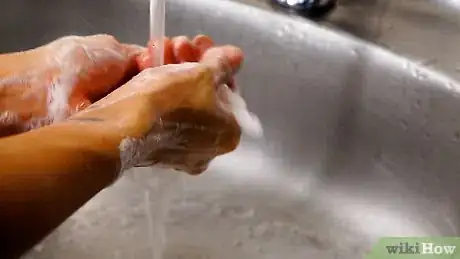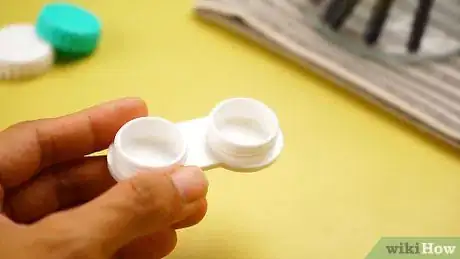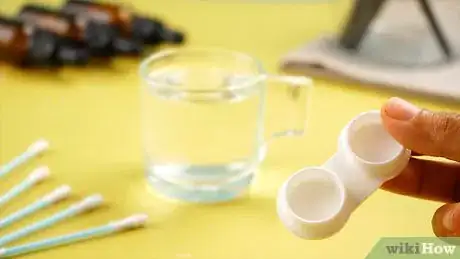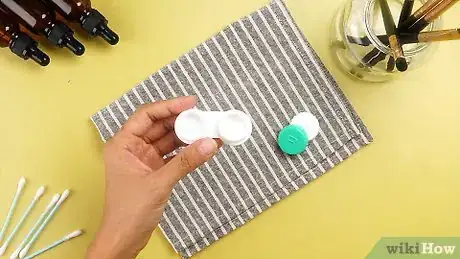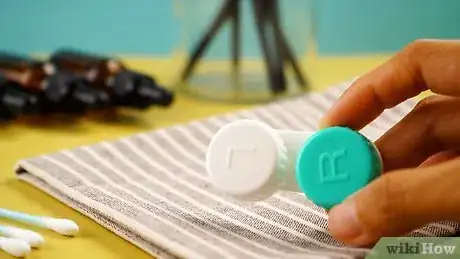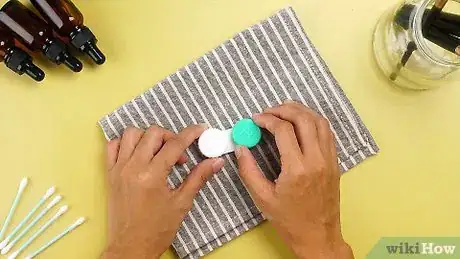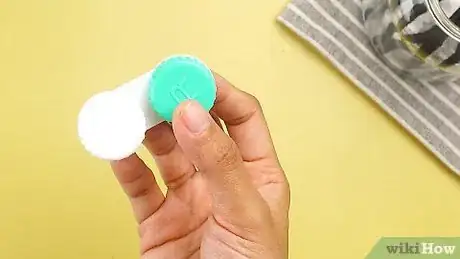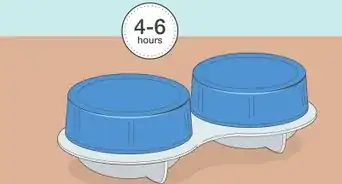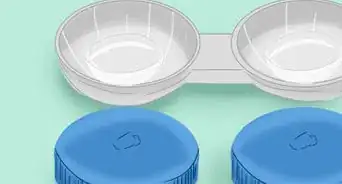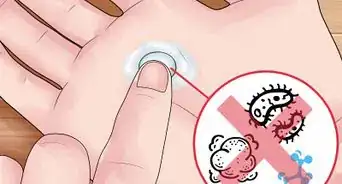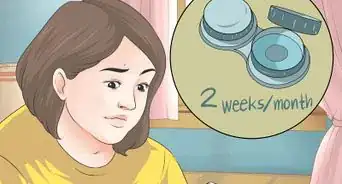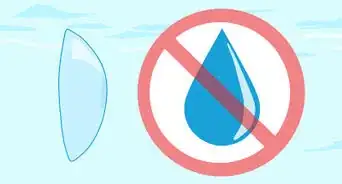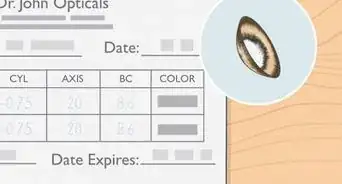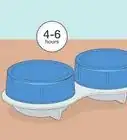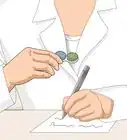This article was co-authored by Alexander Knezevic, MD. Dr. Alexander Knezevic is an Ophthalmologist at the Macy Eye Center in Los Angeles, California. He also is Medical Staff at Cedars-Sinai Medical Center and is a Clinical Instructor of Ophthalmology at UCLA. He graduated with his Doctor of Medicine degree from the University of Nebraska Medical Center, and he completed his Residency at the McGaw Medical Center of Northwestern University. Dr. Knezevic did his Fellowship at the University of California-Irvine, and he’s board certified by the American Board of Ophthalmology. Additionally, Healthgrades has awarded him their Honor Roll award.
There are 16 references cited in this article, which can be found at the bottom of the page.
This article has been viewed 101,751 times.
It’s important for the health of your eyes to keep your contact lens case clean. Your case can harbor dangerous bacteria if not sanitized properly on a daily, weekly, and monthly basis. You’ll want to begin by draining and rinsing your case out with lens solution. Let your case air dry to remove any additional contaminants. Establish a regular cleaning routine and you will move through this process in just minutes.
Steps
Getting Ready to Clean
-
1Wash your hands. Before you touch your contacts or any part of your case you need to wash your hands with warm water and soap.[1] Hold your hands under the water and sing the “Birthday Song” to ensure that they are properly clean. Being vigilant about handwashing will prevent the transfer of bacteria from your hands to your eyes.[2]
- For best results, use an all-natural soap that does not contain additional fragrances or moisturizers. These chemicals can transfer from your hands to the case and then to your eyes.[3]
- When you know you are going to handle your case or contacts, dry your hands off with a lint-free towel. This will prevent fibers from making their way into your case and causing eye irritation.[4]
-
2Empty your case. Grab your case and unscrew the lids from the wells (if they are closed). Set the lids aside. Turn the case upside down over your sink and drain out the old solution. Shake the case a bit to remove any leftover moisture.
- This may sound like common sense, but check that your contacts are not in the case before you empty it.
Advertisement -
3Never “top-off” the solution. If you see leftover lens solution in your case, resist the urge to add solution to it and move on. Reusing solution in this way lessens its sanitizing effects and can lead to a bacterial infection.[5]
Cleaning Your Case on a Daily Basis
-
1Scrub the inside of the case. Using a clean, lint-free rag or a washed finger, gently rub inside the case wells to dislodge any biofilm that may be stuck to the plastic. To achieve maximum cleanliness, try to cover all interior surfaces of the case and spend at least five seconds rubbing each area.[6]
-
2Rinse out the case with a lens solution. Get out your bottle of multi-purpose contact solution and gently spray into the open case.[7] Continue until you are satisfied that any debris have been removed. Don’t forget to spray solution onto the underside of the lids as well.
- Spraying is a critical step in bacteria prevention. One study reported that 70% of contact cases contained bacteria and other contaminants.[8]
- Make sure to use the multi-purpose solution that your doctor suggested. Using a standard saline solution or wetting solution will not sanitize your case properly.[9]
-
3
-
4Let your case air dry. After you’ve completed the rinsing process, set out a clean tissue or a clean lint-free cloth. Place the case and lid caps on the tissue. Place them either facing up or down, depending on your preference. Some argue that face down is better as it protects the case from airborne contaminants, like those commonly found in a bathroom.[12]
-
5Refill your case with solution. When your case is completely dry, you can then refill it with fresh contact solution. It is ready to store your contacts at this point.
-
6Store your case in an appropriate area. Consider carefully where you place your contact case during all phases of use. Cases are more likely to be exposed to bacteria in humid environments. Leaving your case in a bathroom, and near a toilet, in particular, may cause it to come into contact with contaminated water droplets. You may want to consider a nightstand as an alternative storage option.[13]
Caring for Your Case in the Long Term
-
1Throw away your case if it is damaged. Each day take a quick look at your case to see if it has developed any cracks. Even a crack in the lid threading can let bacteria into the interior well area. Or, if you drop your case and it sustains damage, you may want to consider replacing it early.[14]
-
2Clean your case weekly. Take out a fresh, clean toothbrush used expressly for this purpose. Get out your bottle of contact solution as well. Wet the toothbrush with the solution and scrub out the interior and lids of your case. When you are done, rinse it out with solution and let your case air dry.[15]
- Some people contend that boiling your case is the best weekly cleaning method. If you would like to try this, you will need to dip your case into boiling water for at least three minutes. Be very careful to avoid burns.[16] Other people recommend that you run your case through the dishwasher.[17]
- If you detect visible dirt or hard biofilm on your case during your weekly cleaning, you may want to consider replacing it early.[18]
-
3Replace your case every three months.[19] When you get a new case, turn it over and write the date on the bottom with a sharpie. This way you’ll know when you need to replace it. Bacteria begins to accumulate in a case after just one week of use, so three months of usage is really the limit. Don’t wait until your doctor gives you a replacement. You can purchase a new case at the pharmacy or grocery store.[20]
- In one study, 47% of contacts users admitted to never replacing their lens case.[21]
- You may be tempted to keep using your case if it doesn’t look dirty or worn. However, be aware that most bacteria are not able to be seen by the naked eye.[22]
- Many contact solutions come with a new case, so you can throw away the old one each time you buy new solution.
-
4Purchase a bacteria-resistant case. Researchers have been developing a contact lens case that repels bacteria. The case is currently being tested and could be on the market shortly.[23]
Warnings
- Be aware that you must use your contact solution before its expiration date. The solution will lose its antibacterial effectiveness as it moves past that date.[26]⧼thumbs_response⧽
- If you experience any pain, blurriness, or redness in your eyes it may be a sign of a serious infection, despite properly cleaning your case. Contact your eye doctor immediately.[27]⧼thumbs_response⧽
References
- ↑ Alexander Knezevic, MD. Ophthalmologist. Expert Interview. 23 October 2022.
- ↑ http://www.fda.gov/MedicalDevices/ProductsandMedicalProcedures/HomeHealthandConsumer/ConsumerProducts/ContactLenses/ucm062584.htm
- ↑ http://health.usnews.com/health-news/health-wellness/articles/2013/10/18/7-sins-of-contact-lens-wearers
- ↑ https://visionsource-allen.com/2013/12/11/what-every-contact-lens-wearer-needs-to-know/
- ↑ http://www.fda.gov/MedicalDevices/ProductsandMedicalProcedures/HomeHealthandConsumer/ConsumerProducts/ContactLenses/ucm062584.htm
- ↑ http://www.cdc.gov/contactlenses/care-systems.html
- ↑ Alexander Knezevic, MD. Ophthalmologist. Expert Interview. 23 October 2022.
- ↑ https://www.washingtoneye.com/Chevy-Chase/blog/detail/2013/08/12/making-a-case-for-clean-cases.html
- ↑ http://www.allaboutvision.com/contacts/acanthamoeba-keratitis.htm
- ↑ Alexander Knezevic, MD. Ophthalmologist. Expert Interview. 23 October 2022.
- ↑ http://www.fda.gov/MedicalDevices/ProductsandMedicalProcedures/HomeHealthandConsumer/ConsumerProducts/ContactLenses/ucm062584.htm
- ↑ http://www.aoa.org/news/clinical-eye-care/3-hygiene-habits-linked-to-contaminated-contact-lens-cases?sso=y
- ↑ http://www.contactlenssafety.org/lenscases.html
- ↑ https://www.aao.org/eye-health/glasses-contacts/contact-lens-care
- ↑ http://www.nhs.uk/Livewell/Eyehealth/Pages/Contactlenssafety.aspx
- ↑ http://www.allaboutvision.com/contacts/acanthamoeba-keratitis.htm
- ↑ http://www.1800contacts.com/connect/articles/how-clean-contact-lens-case
- ↑ http://www.huffingtonpost.com/2013/09/26/contact-lens-hygiene-questions-answers-eye-health_n_3950593.html
- ↑ Alexander Knezevic, MD. Ophthalmologist. Expert Interview. 23 October 2022.
- ↑ https://www.washingtoneye.com/Chevy-Chase/blog/detail/2013/08/12/making-a-case-for-clean-cases.html
- ↑ http://www.npr.org/sections/health-shots/2011/12/13/143444214/dirty-little-secret-almost-nobody-cleans-contacts-properly
- ↑ http://www.contactlenssafety.org/lenscases.html
- ↑ https://www.washingtoneye.com/Chevy-Chase/blog/detail/2013/08/12/making-a-case-for-clean-cases.html
- ↑ http://www.aao.org/eye-health/glasses-contacts/contact-lens-care
- ↑ http://www.aoa.org/news/clinical-eye-care/3-hygiene-habits-linked-to-contaminated-contact-lens-cases?sso=y
- ↑ http://www.fda.gov/MedicalDevices/ProductsandMedicalProcedures/HomeHealthandConsumer/ConsumerProducts/ContactLenses/ucm062584.htm
- ↑ http://www.preventblindness.org/acanthamoeba-keratitis-and-contact-lenses
About This Article
Before cleaning a contact lens case, wash your hands with soap and water. Empty the old contact lens solution out of the case, then wipe out the inside of the case with a clean, lint-free cloth. Rinse the inner surfaces with an all-purpose contact solution. Set your case out on a clean cloth or tissue with the lids off or open and let it air dry. Once your case is completely dry, refill it with fresh contact solution and close it tightly. Once a week, give your case a more thorough cleaning by scrubbing it with a clean toothbrush dipped in contact lens solution. To learn how to tell when you need a new contact lens case, read on!
